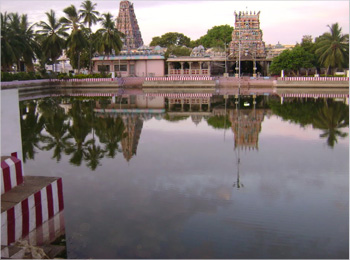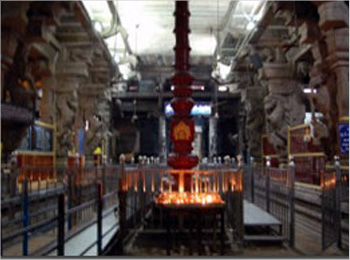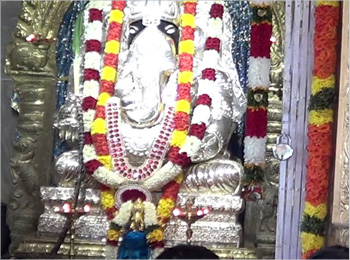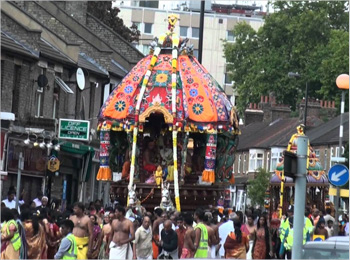- Ganesh
Sri Karpagavinayaka Temple
- Pillaiyarpatti,Tamil Nadu
- View on map
- Tell us about this temple
Overview
This article is about the municipality in Tamil Nadu, India. For its namesake district, see Sivagangai district.Sivagangai is a town and headquarters of the Sivaganga district in the South Indian state of Tamil Nadu. It is also the headquarters of the Sivaganga taluk. The town is located at a distance of 48 km (30 mi) from Madurai and 449 km (279 mi) from the state capital Chennai.
Sivagangai kingdom was founded by Sasivarna Periya Oodaya Thevar in 1730. The town was subsequently ruled by his successors and ultimately by Velu Nachiyar under the stewardship of Maruthu Pandiyar. They were against the British Empire, but ultimately lost to them in 1790. The Company appointed Gowry Vallaba Periya Oodaya Thevar as the Zamindar of Sivaganga in 1801, whose successors continued with chaos until India's independence in 1947. It was under Ramnad district until 1984 and subsequently a part of the newly formed Sivaganga district. The town is known for agriculture, metal working and weaving. The region around Sivaganga has considerable mineral deposits.
Sivaganga is administered by a municipality established in 1965. As of 2011, the municipality covered an area of 6.97 km2 (2.69 sq mi) and had a population of 40,403. Sivagangai comes under the Sivaganga assembly constituency which elects a member to the Tamil Nadu Legislative Assembly once every five years and it is a part of the Sivaganga constituency which elects its Member of Parliament (MP) once in five years. Roadways are the major mode of transportation to the town and it also has rail connectivity. The nearest seaport, Thoothukudi Port, is located 189 km (117 mi) from Sivaganga, while the nearest airport, Madurai International Airport, is located 53 km (33 mi) from the town.
About the temple

Karpaga Vinayagar koil is one of the oldest Cave Temples (Rock Cut) temples of Tamilnadu and situated at Pillayarpatti, which is between Pudukkottai and Karaikkudi. The nearest airport is at Tiruchirappalli, Chennai. Rameswaram Express and Kamban Express travel to these two railheads.
The town of Pillaiyarpatti is named after 'Pillayar' - the tamil name for Ganesha, and this ancient temple houses rock cut images of Shiva, Lingodbhavar and others as well as several other shrines. Steeped in the tradition of Agamic texts the temple bears testimony to the vibrant temple culture of the Tamil people, passed down through centuries.
Antiquity
Over 15 inscriptions are found within the temple, that helps establish the age of the temple. The Stalapuranam published by the temple classifies the growth of this temple into three distinct stages.
The first stage goes back in time by about 1600 years. During this period, the innermost rock cut shrines housing Karpaka Vinayakar and Tiruveesar came into being. The uniqueness of the image of Ganesha is one factor testifying this date; the characters used in the temple inscriptions also help establish this date. The pillars within the shrine are of pre-Pallava origin.
The Pallavas were prolific builders of rock cut temples (Mahabalipuram, Mahendravadi, Mamandur, Mandakapattu, Seeyamangalam, Namakkal, Tiruchi, Nartamalai, Kudumiyanmalai, Tirukkokarnam, Tirumeyyam, Peraiyur, Malayadipatti, Tirukolakkudi, Kunrakkudi etc.). A number of these can be traced to Mahendravarman I (615 - 630 AD) and Narasimhavarman I (630 - 668 AD). However, the inscriptions at Pillayarpatti date further back to the 4th century AD. Also, given the location of the temple in the Pandya kingdom it would only be logical to associate Pandya patronage to this temple, especially in the light of Pandya patronage at the Kazhugumalai temple not too far from here. There are several inscriptions within this temple that date back to the period between 1091 AD and 1238 AD, making it apparent that the Pillayarpatti Nagarattar became the custodians of the temple during the 13th century AD during the second growth phase of this temple, when Vimanams and Rajagopurams were built.
The third phase of growth is much more recent and it involved the repair, rebuilding and refurbishment of the entire temple complex, including the renovation of the temple tank. The tank and the two Raja Gopurams provide an attractive approach to the temple, in this rather remote town of Pillayarpatti.
Daily Worship
Daily pujas are performed in the traditional manner. The murthis are lovingly bathed and dressed, then offered flowers, sandal paste, incense, and food. The types and quantities of food offerings were dictated to Annada Thakur by Sri Ramakrishna in dreams, and these instructions are still strictly followed today. Because the temple itself is rather small inside, the food offerings are made in the nearby Bhog Ghar, a separate building in full view of the temple altar. The food thus blessed by having been offered is then distributed as prasad to all visitors.
About The Deity

Karpaka Vinayakar or Desi Vinayaka Pillaiyar is the presiding deity here, and he is portrayed with two arms and a trunk curled towards his right in the valampuri mode. This 6 feet tall mammoth image of Ganesha is a bas relief in an excavated cave, off of a hill in the precincts of the temple. Scholars says that Lord Vinayaga is the Lord of wisdom, which is confirmed by the head of elephant in the shape of sacred mantram "OM". When we draw a line from the broken left tusk, starting upward, then turning left to wards right ear and after passing through the bended left tusk up to the tip of trunk, Tamil alphabet "O" appears. The Lingam in the hand indicates the alphabet "M". Together they form "OM". This is confirmed by the lord here "Valamburi Pillayar". As Vinayagar satisfies the wishes of his devotees like Karpagam tree, he is also known "Karpaga Vinayagar".
Here Lord Vinayaga appears with 2 hands unlike in other places where he is seen with 4 hands. Also he is seen seated without Angusapasam, with his legs folded and stomach not touching the Asanam in the form of "Artha Padma" Asanam.
The word Vinayaga means "Incomparable Leader" Devotees worshipping Valamburi Vinayagar seated facing towards north, will be blessed with all wealth. Chanting of sacred mantrams by the student learning Vedas and agamas in the Vedaagama School create a divine atmosphere.
The deity of this temple is known as "Marudeeswarar" as Marudha tree (In Sansscrit Arjuna Virutcha,Tne Botanical name is Termanalia Arjuna) worship is followed in this temple whichindicates that this temple in an ancient temple. The sculptur of pasupatheeswarar, "A cow worshipping Lord Siva by offering his milk" is the special feature of this temple. Also kubheran the Lord of wealth had worshipped at this temple.
To illustrate the information that one where controls his five senses will be able to understand God, a sculplure of five headed snake wearing a Lingam on its neck is found here. The five head of the snake indicate the five senses while the Lingam indicates God. Also adding to the sprituality Goddess Laxmi, Saraswathi and Durgai are found together at the same sport.
Unlike other places the three Lingams Thiruveesar, Marudheesar and Senchadeswarar and the three Goddess Sivagami amman, Vadamalar Mangaiamman and Soundara Nayaga amman all appear together at the same place and bless the devotees.
Presiding Deity - Karpaga Vinayagar
This village derives its name from the image of Lord Ganesha, known as Karpaga Vinayaka, carved on the wall of an ancient rock-cut temple. The Lord is seated and appears with only two arms, the left being on the right holding a modhaka. The trunk is turned to the right. There is no sacred thread on this Ganesha sculpture.
The word Vinayaga means "Incomparable Leader" Devotees worshipping Valamburi Vinayagar seated facing towards north, will be blessed with all kinds of wealth. Kubera, the Lord of Wealth is said to have worshipped at this temple. Goddess Laxmi, Saraswathy and Durga are found together in this temple.
The three Lingams - Thiruveeswarar, Marudheeswarar and Senchadeswarar and the three Goddesses - Sivagami amman, Vadamalar Mangaiamman and Soundara Nayaga Amman all appear together at the same place and bless the devotees.
Legend and stories

This is an ancient rock cut temple. Scholars says that Lord Vinayaga is the Lord of wisdom, As Vinayagar satisfies the wishes of his devotees like Karpagam tree, he is also known "Karpaga Vinayagar". Here Lord Vinayaga appears with 2 hands unlike in other places where he is seen with 4 hands. Also he is seen seated without Angusapasam, with his legs folded and stomach not touching the Asanam in the form of "Artha Padma" Asanam. The word Vinayaga means "Incomparable Leader" Devotees worshipping Valamburi Vinayagar seated facing towards north, will be blessed with all wealth. Also adding to the sprituality Goddess Laxmi, Saraswathi and Durgai are found together at the same sport. Unlike other places the three Lingams Thiruveesar, Marudheesar and Senchadeswarar and the three Goddess Sivagami amman, Vadamalar Mangaiamman and Soundara Nayaga amman all appear together at the same place and bless the devotees.
Legends Karpaka Vinayakar is portrayed with two arms and a trunk curled towards his right in the valampuri mode. This 6 feet tall mammoth image of Ganesha is a bas relief in an excavated cave, off of a hill in the precincts of the temple. When we draw a line from the broken left tusk, starting upward, then turning left towards right ear and after passing through the bended left tusk up to the tip of trunk, Tamil alphabet "O" appears. The Lingam in the hand indicates the alphabet "M". Together they form "OM".
Festivals
"Vinayagar Chaturthi" celebrated every year on Aavani is the important festival of this village. This festival is celebrated for 10 days in a grand manner. The festival will begin with Kappukattu and flag hoisting on the first day, cultural programs are conducted from 6th day onwards. During the day and night, Lord Vinayaga is taken around in procession through the streets where he is seated in different vahanams every day.
1st day Silver Muueshika Vahanam
2nd day Simma Vahanam
3rd day Boodha Vahanam
4th day Kamala Vahanam
5th day Siver Rcishaba Vahanam
6th day Silver Elephant Vahanam upto Kagamugasura Samkaram and then in Golden Bandicoot Vahanam
7th day Silver Peacock Vahanam
8th day Horse Vahanam
9th day Car, Elephant Vahanam
10th day Theerthavari will be celebrated in the morning during night the Procession of five Lords seated in silver and golden Vahanam will take place.
During Thiruvadhirai, Sivakama Sundari Samedha Natarajaperuman is taken around the streets in procession. Apart from this festival a ten day festival for kongunachiamman village Goddess is celebrated in the month of vaikashi.
Pooja Timings
The temple has 5 kaala poojas. The timings are:
1. Thiruvanandal - 06.00 a.m.- 06.30 a.m.
2. Kaalasanthi - 08.30 a.m. - 09.30 a.m.
3. Uchikalam - 11.30 a.m.- 12.00 p.m.
4. Maalaisanthi or Sayaratsai - 05.00 p.m. - 06.30 p.m.
5. Iravusanthi or Arthajaman - 07.45 p.m. - 08.30 p.m.
During Thaipoosam and Sabari malai Festival (November to Janauary 20) the temple will be open from 06.00 a.m to 08.30 p.m.
Prasad and Offering
Prasadam Speciality on Vinayagar Chathurthi Day: A single giant Kozhukattai prepared with 18 measures of rice, 2 measures of Til (Ellu in Tamil), 6 measures of Dhal, 50 coconuts, one measure of cow ghee, 100 gms cardamom, 40 kg Jaggery is offered to Lord as Nivedhyam. The whole mixture is packed in a cloth and placed in the big rice basket (Anna Koodai in Tamil) in the temple kitchen. This will then be put into an Anda, big bowl and tied in the kitchen. This will be boiled for two whole days continuously. Next day after the preparation is cooled; this will be tied to a long wood and carried to the shrine for Nivedhyam and it would be made into pieces and offered to devotees as Prasad.
Significance
It is believed that by worshipping Kathyayini amman at this temple women get relived from sevvai dosham which prevent them from getting married. "Sabda Madhar" are given importance due to changing time are provided with a separate sannidhi known as Sakthi sannidhi at this temple.
Nearby Places to Visit
Other temples in the area near Pillayarpatti are: Thirumayam (23 kms) on the Pudukkottai - Pillayarpatti Road has ancient Shiva and Vishnu cave temples. Kunrakudi (10 kms from Karaikudi) has a Shanmuganathan (Lord Muruga) temple that was built around 1000 AD.
Accessibility
Airport
The nearest airports are at Tiruchirappalli (72 kms), Madurai (100 to 108 kms) and Chennai (International, 400 kms).
Railways
One can also approach the region by rail, taking the Rameswaram Express and Kamban Express from Chennai go to both these railheads.
Road
One can reach Pillayarpatti from two cities between which it is situated, namely, Pudukkottai and Karaikkudi.
Temple Address
Karpaka Vinayakar Temple,
Sivaganga, Tamil Nadu, India,
Pincode – 630561.
Significance
Devotees visit this temple to seek fulfillment of the following:-
- To attain happiness
Shlokas
Vakratunda Mahakaaya Suryakoti Samaprabha Nirvighnam Kuru Mey Deva Sarva Kaaryeshu Sarvada
Meaning -I pray to thee O Lord, who has a curved trunk and a strong body, the shine of a million suns, to remove all the hurdles that may block me from all the tasks I intend to perform.
Agajaanana Padmaarkam Gajaananam Aharnisham Anekadantham Bhaktaanaam Ekadantam Upaasmahey
Meaning -The sun to Mother Parvati's lotus face, I worship Lord Ganesh, with the elephant face, the one who grants a lot of wishes, the one with the single tusk, I salute thee to grant my wish.
Gajaananam Bhoota Ganaadhi Sevitam Kapitta Jamboophaala Saara Bhakshitam Umaasutam Shoka Vinaasha Kaaranam Namaami Vighneswara Paada Pankajam
Meaning -Oh elephant-faced Lord, who is served by all the Ganas, who consumes the essence of Kapitta and Jamboophala, His favourite fruits, who is Uma's son, who destroys the gloom of His devotees, who handles hurdles, we worship your lotus feet.
Tatpurushaaya Vidmahe Vakratundaaya Dheemahe Tanno Danthihi Prachodayaat
Meaning -We meditate on the great power, we call upon the single tusked Ganesh, who grants wishes.
Timings
6 a.m. to 1 p.m.4 p.m. to 8.30 p.m.From November to January 20 the temple is open from 6 a.m. to 08:30 p.m. Everyday
